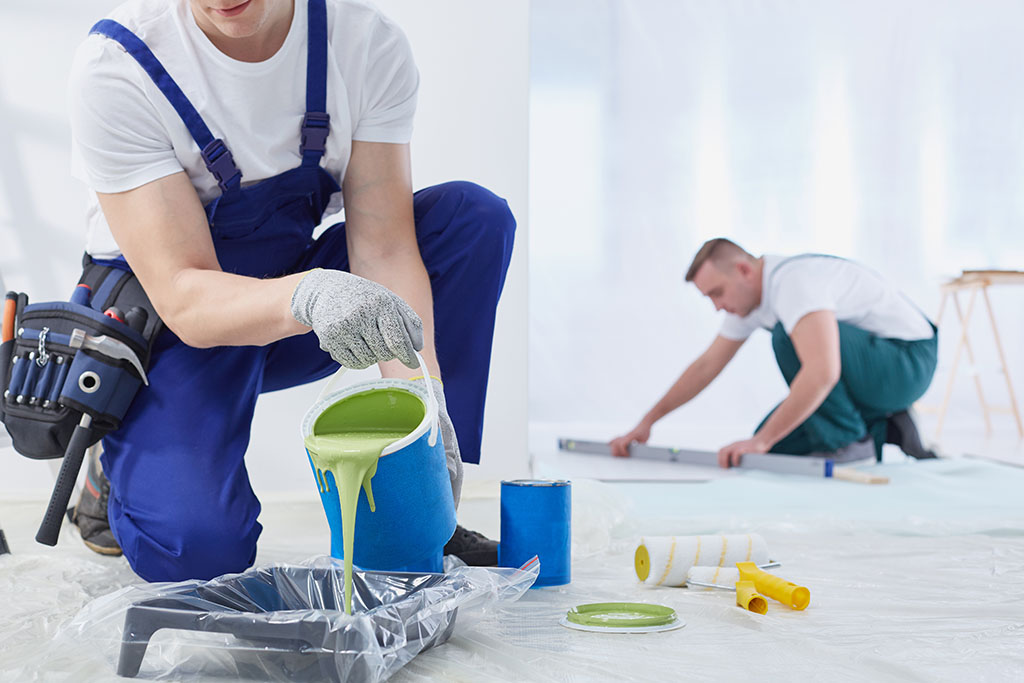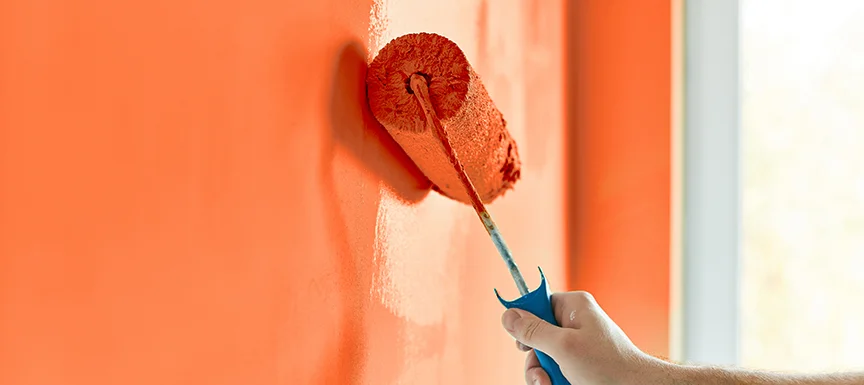How corpus christi paint store Helps Homeowners Achieve elegant Results with efficiency
Discovering the Various Sorts Of Paint: A Guide for Every Project
Discovering the numerous kinds of paint is vital for accomplishing the desired outcome in any kind of job. From water-based choices that provide convenience to oil-based paints recognized for their durability, each selection has its qualities. Specialized paints can add one-of-a-kind appearances or surfaces, while environment-friendly options cater to those looking for sustainability. Comprehending these differences can considerably impact the success of a paint undertaking. What aspects should one think about when making the right option?
Understanding Paint Kinds: Water-Based vs. Oil-Based
Paint kinds can noticeably impact a task's outcome, and recognizing the differences in between water-based and oil-based paints is crucial for notified decision-making. Water-based paints, often referred to as latex paints, are made up of water as the primary solvent. They completely dry quickly, discharge fewer unstable natural compounds (VOCs), and are very easy to tidy up with soap and water. This makes them a prominent selection for interior applications and settings where air quality is a worry.
In contrast, oil-based paints make use of organic solvents, giving a resilient, shiny coating ideal for surfaces revealed to damage, such as trim and closets. They take longer to dry, need mineral spirits for cleanup, and have a stronger smell. paint store corpus christi tx. Choosing in between these 2 types relies on the certain requirements of the project, thinking about factors such as preferred finish, application atmosphere, and ease of maintenance. Each kind has distinct benefits and restrictions, directing the selection process
The End Up Matters: Selecting In Between Matte, Satin, and Gloss
When selecting a paint coating, the option between matte and glossy options substantially influences both aesthetic appeals and performance. Matte surfaces use a refined, non-reflective appearance that can hide surface area flaws, while shiny finishes provide resilience and convenience of cleaning. Understanding the advantages and considerations of each can assist in making an educated decision for any type of paint task.
Matte Finish Benefits
Lots of house owners question the qualities of various coatings, matte paint provides distinct benefits that make it a prominent option for both indoor and outside applications. Among the primary benefits of matte surface is its ability to conceal surface area blemishes, developing a smoother appearance on walls. This top quality is specifically useful in older homes or rooms with uneven surfaces. In addition, matte paint takes in light as opposed to showing it, which can enhance the visual of a room by supplying a much more soft and sophisticated look. In addition, matte surfaces are typically simpler to touch up than glossier alternatives, as they can blend a lot more flawlessly when used over existing paint. In general, matte paint is a superb choice for those looking for a refined and classy coating.
Shiny Finish Factors To Consider
A glossy surface can substantially change the assumption of a room, offering a reflective and sleek high quality that improves both color vibrancy and light within a room. This coating is frequently preferred for high-traffic locations and surface areas like bathroom and kitchens, where longevity and simplicity of cleansing are important. Nonetheless, its reflective nature can highlight blemishes on wall surfaces, making proper surface area prep work critical. Glossy paints likewise tend to show smudges and fingerprints quicker, demanding normal maintenance. Additionally, lighting plays a considerable role; in brilliant settings, a shiny surface may develop glare, influencing the general visual. Careful factor to consider of the particular application and atmosphere is important when choosing a glossy finish for any job.
Specialized Paints: When to Use Distinctive or Chalk Paint
Specialized paints, such as textured and chalk paint, offer one-of-a-kind visual and functional advantages that can improve different surface areas. Textured paint is excellent for creating deepness and dimension on walls, hiding flaws while adding a three-dimensional feeling. It is specifically advantageous in high-traffic locations where durability and visual interest are crucial.

Both sorts of specialized paints can transform spaces, however picking the right one relies on the wanted result and surface demands. Distinctive paint may suit bigger locations, while chalk paint can renew smaller sized things, showcasing creativity and personal style in any job.
Outside Paints: Safeguarding Your Surfaces From the Components
Outdoor paints are necessary for safeguarding surfaces against various climate condition. Understanding their weather condition resistance features, appropriate surface area preparation demands, and reliable application techniques can greatly enhance durability and performance. This area will certainly detail key factors to consider for choose and utilizing outdoor paints successfully.
Climate Resistance Includes
Climate resistance is a necessary feature of outside paints, as it determines how well surface areas can stand up to the extreme aspects of nature. High-grade outdoor paints are developed to stand up to damage from UV rays, dampness, and temperature changes. UV resistance warranties colors continue to be lively over time, preventing fading and discoloration. Wetness resistance shields versus mold and mildew, which can endanger the honesty of surface areas. Furthermore, paints with excellent temperature resistance can expand and get without breaking, maintaining their safety qualities. When choosing exterior paints, it is important to take into account these weather resistance functions, as they add to the durability and sturdiness of colored surface areas, making certain they stay aesthetically pleasing and practical in spite of direct exposure to the elements.
Surface Preparation Demands
Appropriate surface area prep work is a basic action in achieving the best results with outdoor paints. To ensure suitable attachment and longevity, surfaces must be thoroughly cleaned, removing mold, dust, and oil. This can be achieved making use of a stress washing machine or a scrub brush with an appropriate cleansing option. When cleaned up, surfaces should be examined for any peeling or flaking paint, which must be scraped away to develop a smooth structure. Fixing any type of openings or splits is additionally crucial, as these can permit dampness seepage. Furthermore, sanding harsh locations promotes much better paint bond. Finally, using a guide fit for outside use can enhance the paint's efficiency, assuring a resilient coating that holds up against the components. Correct preparation is key to a successful outdoor painting project.
Application Methods Tips
While applying outside paints, it is necessary to make use of reliable methods that guarantee surfaces are well-protected versus the components. Pick the appropriate day for paint; low humidity and mild temperature levels improve bond and drying. Prepping the surface area completely-- cleaning, sanding, and priming-- ensures far better paint bond and durability. Making use of top notch brushes or rollers can supply a smoother coating, while spray painting may cover large locations successfully. Using paint in thin, also coats prevents drips and runs. It is suggested to comply with producer instructions regarding drying out times between layers. Validate appropriate air flow throughout application to assist in drying out and reduce direct exposure to fumes. These methods greatly improve the long life and efficiency of exterior paint.
Eco-Friendly Options: Low-VOC and Zero-VOC Paints
As consumers end up being increasingly knowledgeable about the environmental impact of their choices, zero-voc and low-voc paints have arised as popular choices. These paints are developed to consist of less unpredictable organic substances (VOCs), which are chemicals that can evaporate into the air and add to air pollution and illness. Low-VOC paints commonly consist of a restricted amount of VOCs, while zero-VOC paints have minimal levels, making them much safer for both indoor and outdoor use.
The benefits of utilizing low-VOC and zero-VOC paints extend past ecological considerations; they additionally boost interior air quality, reducing the threat of sensitive reactions and respiratory system issues. Numerous makers now supply a variety of colors and coatings in eco-friendly options, making it less complicated for customers to discover suitable items for their jobs. By going with these paints, people can contribute to a healthier setting while read more still accomplishing the visual they prefer in their spaces.
Devices and Methods for a Flawless Application
Attaining a flawless paint application calls for the right tools and strategies, which can substantially improve the last result. Picking the proper brush or roller is necessary; brushes work well for sides and complex areas, while rollers cover bigger surfaces effectively. Using high-grade materials assures much better paint circulation and lessens streaks. For excellent results, surface area preparation is essential. This consists of cleaning, fining sand, and priming surface areas to promote attachment.
Technique additionally plays a significant function. The "W" method with a roller aids to evenly distribute paint, while long, smooth strokes with a brush protect against visible lines. Operating in areas enables for better control and blending. In addition, using thin coats is preferable to thick layers, minimizing the risk of drips and unequal appearances. Finally, preserving a damp edge throughout application aids achieve smooth changes between locations. By integrating these techniques and tools, one can accomplish a sleek and specialist finish.
Tips for Maintaining and Caring for Your Painted Surfaces
Appropriate upkeep and treatment of coloured surfaces can significantly prolong their life expectancy and maintain their appearance. Regular cleansing is necessary; using a soft fabric or sponge with mild soap and water can eliminate dust and dirt without damaging the paint. It is advisable to avoid rough cleansers or rubbing pads, as these can scrape the surface. In addition, using a fresh coat of paint every couple of years can shield and renew the shade against wear.
For outdoor surfaces, inspecting for indicators of peeling off or fading regularly is essential. Without delay addressing any kind of concerns avoids further damages. In locations susceptible to moisture, such as washrooms, making use of mold-resistant paint and making sure appropriate ventilation can aid keep the stability of the paint. Using protective coatings can protect against UV rays and discolorations, guaranteeing that painted surface areas continue to be attractive and vibrant for years to come, eventually enhancing the overall aesthetic of the room.

Often Asked Concerns
Can I Mix Different Kind Of Paint Together?
Mixing different types of paint is generally not recommended, as it can result in issues like poor adhesion, inconsistent appearance, or unanticipated chain reaction. It's ideal to utilize compatible paints for perfect results and resilience.

Just how Do I Correctly Shop Leftover Paint?
To appropriately save leftover paint, seal the container securely, tag it with the date and color, and maintain it in a cool, dry location far from straight sunlight and extreme temperature levels for ideal preservation.
What Is the Finest Means to Dispose of Unused Paint?
The very best means to deal with extra paint is to check local policies, as lots of locations have actually marked contaminated materials facilities. Take into consideration donating usable paint to community organizations or schools for their projects.
How Can I Tell if Paint Is Still Great to Utilize?
To figure out if paint is still great, examine its consistency, smell, and color. If it shows up separated, has an unpleasant smell, or shows considerable adjustments in appearance, it's likely no longer usable.
Exist Age Restrictions for Investing In Paint Products?
In many areas, there are no certain age restrictions for acquiring paint products. However, some shops may require consumers to be at the very least 18 years of ages, especially for items consisting of solvents or unsafe materials.
Paint types can considerably affect a project's end result, and comprehending the differences in between water-based and oil-based paints is crucial for informed decision-making. Water-based paints, commonly referred to as latex paints, are made up of water as the primary solvent. In contrast, oil-based paints utilize organic solvents, providing a sturdy, glossy surface ideal for surfaces revealed to wear and tear, such as trim and closets. Specialty paints, such as distinctive and chalk paint, deal distinct visual and practical benefits that can boost numerous surfaces. In areas vulnerable to moisture, such as shower rooms, making use of mold-resistant paint and guaranteeing correct air flow can help preserve the honesty of the paint.